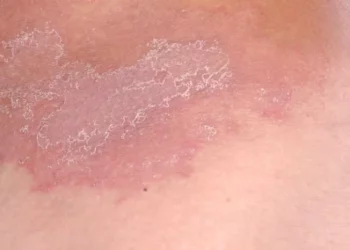Ringworm on the scalp, also known as tinea capitis, is a common fungal infection that affects both children and adults. Despite its name, ringworm is not caused by a worm but by dermatophytes, a group of fungi that thrive on keratin, the protein found in skin, hair, and nails. Understanding the causes, symptoms, and treatment options for this condition is crucial for effectively managing and curing it.
SEE ALSO: Is Ringworm Chronic?
Understanding Ringworm on the Scalp
Definition and Causes
Ringworm on the scalp is a contagious fungal infection characterized by scaly, itchy patches on the skin. The fungi responsible for this condition, typically from the genera Trichophyton or Microsporum, spread through direct contact with an infected person, animal, or contaminated object such as combs, brushes, or hats. The infection is particularly prevalent in children due to their close physical interactions in schools and playgrounds. Warm, humid environments also contribute to the spread of the fungi, making the condition more common in such climates.
Symptoms
The symptoms of scalp ringworm can vary but typically include:
Itching: A persistent itchy sensation on the scalp is often the first sign of infection.
Hair Loss: Patches of hair may fall out, leaving bald spots where the fungus has invaded the hair follicles.
Scaly Patches: The infected areas may develop scaly, dry, and flaky skin, which can sometimes appear red or inflamed.
Black Dots: In cases where the hair breaks off at the scalp surface, small black dots may be visible.
Pain and Tenderness: The affected area may become tender or painful, particularly if secondary bacterial infection occurs.
Diagnosis
Proper diagnosis of scalp ringworm is essential to ensure effective treatment. A doctor or dermatologist will typically diagnose the condition based on the appearance of the symptoms and may confirm it using one or more of the following tests:
Wood’s Lamp Test: A special ultraviolet light that can help identify fungal infections by causing them to fluoresce.
Microscopic Examination: A sample of hair or skin scraping may be examined under a microscope to detect the presence of fungi.
Fungal Culture: A sample from the infected area can be cultured in a lab to identify the specific type of fungus causing the infection.
Treatment Options
Over-the-Counter Medications
For mild cases of scalp ringworm, over-the-counter (OTC) antifungal treatments may be effective. Antifungal shampoos containing ingredients like ketoconazole or selenium sulfide can help reduce fungal spores on the scalp and soothe irritation. While these treatments can provide relief, they are often more effective when used in conjunction with prescription medications.
Prescription Medications
In more severe cases or when OTC treatments are insufficient, prescription antifungal medications are required. The most commonly prescribed oral antifungal medications include:
Griseofulvin: This is often the first-line treatment for scalp ringworm and is taken orally for several weeks to ensure the complete eradication of the fungus.
Terbinafine: Another effective oral antifungal medication, terbinafine is often used for cases where griseofulvin is ineffective or not tolerated by the patient.
Itraconazole and Fluconazole: These are alternative antifungal medications that may be prescribed in certain cases.
It is crucial to complete the full course of medication as prescribed by a healthcare provider, even if symptoms improve before the treatment period ends.
Home Remedies
While home remedies can provide temporary relief from symptoms, they should not replace medical treatment. Remedies such as tea tree oil, apple cider vinegar, or coconut oil may have antifungal properties and can be applied to the scalp to help alleviate itching and reduce the spread of the infection. However, these should only be used as supplements to prescribed antifungal treatments, not as standalone cures.
Lifestyle Changes
Maintaining good hygiene is vital for preventing the spread of ringworm and supporting recovery. Regularly washing the hair with medicated shampoos, avoiding the sharing of personal items like combs and hats, and keeping the scalp dry and clean are essential practices. Additionally, avoid close contact with individuals known to have ringworm to reduce the risk of transmission.
Prevention
Hygiene Tips
Preventing scalp ringworm involves practicing good hygiene and taking precautions to avoid exposure to the fungi. Key prevention strategies include:
Keep the Scalp Clean: Regularly wash hair and scalp, especially after sweating or exposure to dirty environments.
Avoid Sharing Personal Items: Do not share combs, brushes, hats, or other items that come into contact with the scalp.
Disinfect Commonly Used Items: Regularly clean and disinfect items like hairbrushes and towels.
Educate on Transmission: Inform children and adults alike about the importance of avoiding direct contact with infected individuals or animals.
Conclusion
Scalp ringworm is a common yet treatable condition that requires proper diagnosis and medical intervention for complete recovery. Understanding the symptoms, seeking prompt medical attention, and adhering to prescribed treatments are essential steps in curing the infection and preventing its spread. By practicing good hygiene and being aware of the potential for transmission, individuals can protect themselves and others from this contagious condition. Always consult with a healthcare professional if you suspect you have ringworm on the scalp to ensure appropriate care and treatment.
Related Topics:

























